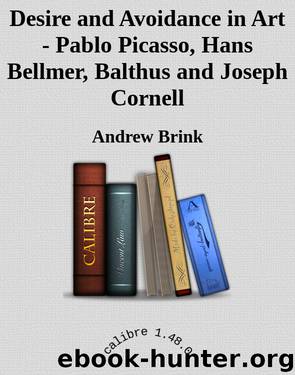Desire and Avoidance in Art - Pablo Picasso, Hans Bellmer, Balthus and Joseph Cornell by Andrew Brink

Author:Andrew Brink [Неизв.]
Language: eng
Format: epub, mobi
Tags: antique
Desire and Avoidance in the Paintings of
Balthus
I’m for beauty at a time when beauty is unappreciated. Dostoyevsky said, “Beauty will save the world”.
—Balthus, Balthus in His Own Words, p 7
Behind the Curtain
Balthus (Count Balthasar Klossowski de Rola 1908-2001) seems a much more humane artist than Bellmer and, by comparison, might be called a humanist. Yet, strangely, Balthus celebrates young girls while avoiding their personhood. His erotic paintings are studies in avoidance, albeit less punishing than Bell-mer’s mechanization of female flesh. Desire for young girls combines with establishing safe distances from them. Girls are observed, but they do not advance towards the viewer; they do not invite approach or touching. They are indeed “untouchables”, static female effigies of some nameless attraction that is also avoidance. Eroticism is held in suspense as if the female part of humanity inhabited a different sphere of life needing the protection of an artificial theatrical setting. Occasionally Balthus’s young females are in relationship with males, other females, diminutive figures or cats, but the most arresting of them are solitary, remote and disturbing. Balthus is no bionic engineer of the female body like Bellmer, nor does he remotely approach Picasso’s misogynic degree of dismemberment and reconfiguration of female portraits; but viewers are apt to find Balthus’ paintings more hauntingly disturbing. Bellmer and Picasso are so extreme in their distorting inventiveness that the results can be dismissed as simply bizarre, but Balthus is a classicist and realist accommodating to every-day reality. They are “real” in the sense that ordinary people perceive each other, yet they seem constrained by some pathology of which Balthus was not fully aware or, at least, was unwilling to disclose.
The first thought is that Balthus was a sort of pedophile, not so much seeking children as young females just entering adolescence. Pubescent girls,
developing the outlines of womanhood, are Balthus’s speciality, the state of femaleness he so eloquently insisted upon in painting. They look like an “obsession”, something happening in the mind for which visual equivalents were repeatedly sought. Girls, not mature women, preoccupied Balthus all his life, and there is reason to suppose that adult sexuality did not much appeal. He confessed, “I could never paint a nude woman. I find the beauty of young girls more interesting and perfect than women’s. They embody becoming, a pre-being, in short they symbolize the most perfect beauty. Woman is a being already ... whereas the adolescent ... hasn’t yet found her place. A woman’s body is generally too defined; a girl’s body is more beautiful. ... Young girls are sacred, divine, angelic beings”.1 We will note comparison with Vladimir Nabokov’s Lolita, vehemently denied by Balthus who felt that his public altogether misjudged him in the matter of erotic preoccupation with young girls. His plea was for a spiritual reading of these creatures, an idealization perhaps more suspect than convincing.
“Angelic” is not a real assessment of young girls unless you don’t know them, observing only from a distance. Nabokov was far more astute in showing the self-centered, bitchy and demanding aspects of the young girls obsessing Humbert Humbert.
Download
Desire and Avoidance in Art - Pablo Picasso, Hans Bellmer, Balthus and Joseph Cornell by Andrew Brink.mobi
This site does not store any files on its server. We only index and link to content provided by other sites. Please contact the content providers to delete copyright contents if any and email us, we'll remove relevant links or contents immediately.
The Art of Boudoir Photography: How to Create Stunning Photographs of Women by Christa Meola(18537)
Red Sparrow by Jason Matthews(5390)
Harry Potter 02 & The Chamber Of Secrets (Illustrated) by J.K. Rowling(3622)
In a Sunburned Country by Bill Bryson(3485)
Drawing Cutting Edge Anatomy by Christopher Hart(3454)
Figure Drawing for Artists by Steve Huston(3382)
Harry Potter and the Prisoner of Azkaban (Book 3) by J. K. Rowling(3304)
The Daily Stoic by Holiday Ryan & Hanselman Stephen(3235)
Japanese Design by Patricia J. Graham(3110)
The Roots of Romanticism (Second Edition) by Berlin Isaiah Hardy Henry Gray John(2878)
Make Comics Like the Pros by Greg Pak(2852)
Stacked Decks by The Rotenberg Collection(2812)
Draw-A-Saurus by James Silvani(2656)
Harry Potter and the Deathly Hallows (7) by J.K. Rowling(2643)
Tattoo Art by Doralba Picerno(2600)
On Photography by Susan Sontag(2575)
Churchill by Paul Johnson(2506)
The Daily Stoic by Ryan Holiday & Stephen Hanselman(2461)
Drawing and Painting Birds by Tim Wootton(2438)
